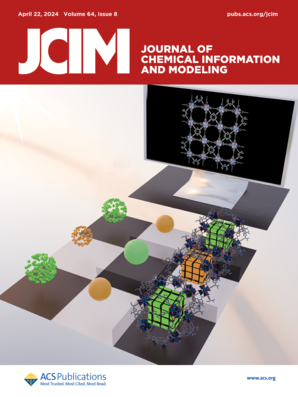Atomistic Insights into the Stabilization of TDP-43 Protofibrils by ATP
IF 5.3
2区 化学
Q1 CHEMISTRY, MEDICINAL
引用次数: 0
Abstract
The aberrant accumulation of the transactive response deoxyribonucleic acid (DNA)-binding protein of 43 kDa (TDP-43) aggregates in the cytoplasm of motor neurons is the main pathological hallmark of amyotrophic lateral sclerosis (ALS). Previous experiments reported that adenosine triphosphate (ATP), the universal energy currency for all living cells, could induce aggregation and enhance the folding of TDP-43 fibrillar aggregates. However, the significance of ATP on TDP-43 fibrillation and the mechanism behind it remain elusive. In this work, we conducted multiple atomistic molecular dynamics (MD) simulations totaling 20 μs to search the critical nucleus size of TDP-43282–360 and investigate the impact of ATP molecules on preformed protofibrils. The results reveal that the trimer is the critical nucleus for TDP-43282–360 fibril formation and the tetramer is the minimal stable nucleus. When ATP molecules bind to the TDP-43282–360 trimer and tetramer, they can consolidate the TDP-43282–360 protofibrils by increasing the content of the β-sheet structure and promoting the formation of hydrogen bonds (H-bonds). Binding site analyses show that the N-terminus of TDP-43282–360 protofibrils is the main binding site of ATP, and R293 dominates the direct binding of ATP. Further analyses reveal that the π–π, cation−π, salt bridge, and H-bonding interactions together contribute to the binding of ATP to TDP-43282–360 protofibrils. This study decoded the detailed stabilization mechanism of protofibrillar TDP-43282–360 oligomers by ATP, and may provide new avenues for the development of drug design against ALS.从原子论角度洞察 ATP 对 TDP-43 原纤维的稳定作用
运动神经元胞质中转录反应脱氧核糖核酸(DNA)结合蛋白 43 kDa(TDP-43)聚集体的异常积累是肌萎缩性脊髓侧索硬化症(ALS)的主要病理特征。之前的实验报告称,三磷酸腺苷(ATP)是所有活细胞的通用能量货币,可诱导 TDP-43 纤维状聚集体的聚集并增强其折叠。然而,ATP对TDP-43纤维化的意义及其背后的机制仍不清楚。在这项工作中,我们进行了总计 20 μs 的多次原子分子动力学(MD)模拟,以寻找 TDP-43282-360 的临界核大小,并研究 ATP 分子对预形成原纤维的影响。结果发现,三聚体是 TDP-43282-360 纤维形成的临界核,四聚体是最小的稳定核。当 ATP 分子与 TDP-43282-360 三聚体和四聚体结合时,它们可以通过增加 β 片状结构的含量和促进氢键(H 键)的形成来巩固 TDP-43282-360 原纤维。结合位点分析表明,TDP-43282-360 原纤维的 N 端是 ATP 的主要结合位点,R293 主导 ATP 的直接结合。进一步的分析表明,π-π、阳离子-π、盐桥和 H 键相互作用共同促成了 ATP 与 TDP-43282-360 原纤维的结合。这项研究详细揭示了ATP对原纤维状TDP-43282-360低聚物的稳定机制,可能为开发ALS药物设计提供新的途径。
本文章由计算机程序翻译,如有差异,请以英文原文为准。
求助全文
约1分钟内获得全文
求助全文
来源期刊
CiteScore
9.80
自引率
10.70%
发文量
529
审稿时长
1.4 months
期刊介绍:
The Journal of Chemical Information and Modeling publishes papers reporting new methodology and/or important applications in the fields of chemical informatics and molecular modeling. Specific topics include the representation and computer-based searching of chemical databases, molecular modeling, computer-aided molecular design of new materials, catalysts, or ligands, development of new computational methods or efficient algorithms for chemical software, and biopharmaceutical chemistry including analyses of biological activity and other issues related to drug discovery.
Astute chemists, computer scientists, and information specialists look to this monthly’s insightful research studies, programming innovations, and software reviews to keep current with advances in this integral, multidisciplinary field.
As a subscriber you’ll stay abreast of database search systems, use of graph theory in chemical problems, substructure search systems, pattern recognition and clustering, analysis of chemical and physical data, molecular modeling, graphics and natural language interfaces, bibliometric and citation analysis, and synthesis design and reactions databases.

 求助内容:
求助内容: 应助结果提醒方式:
应助结果提醒方式:


